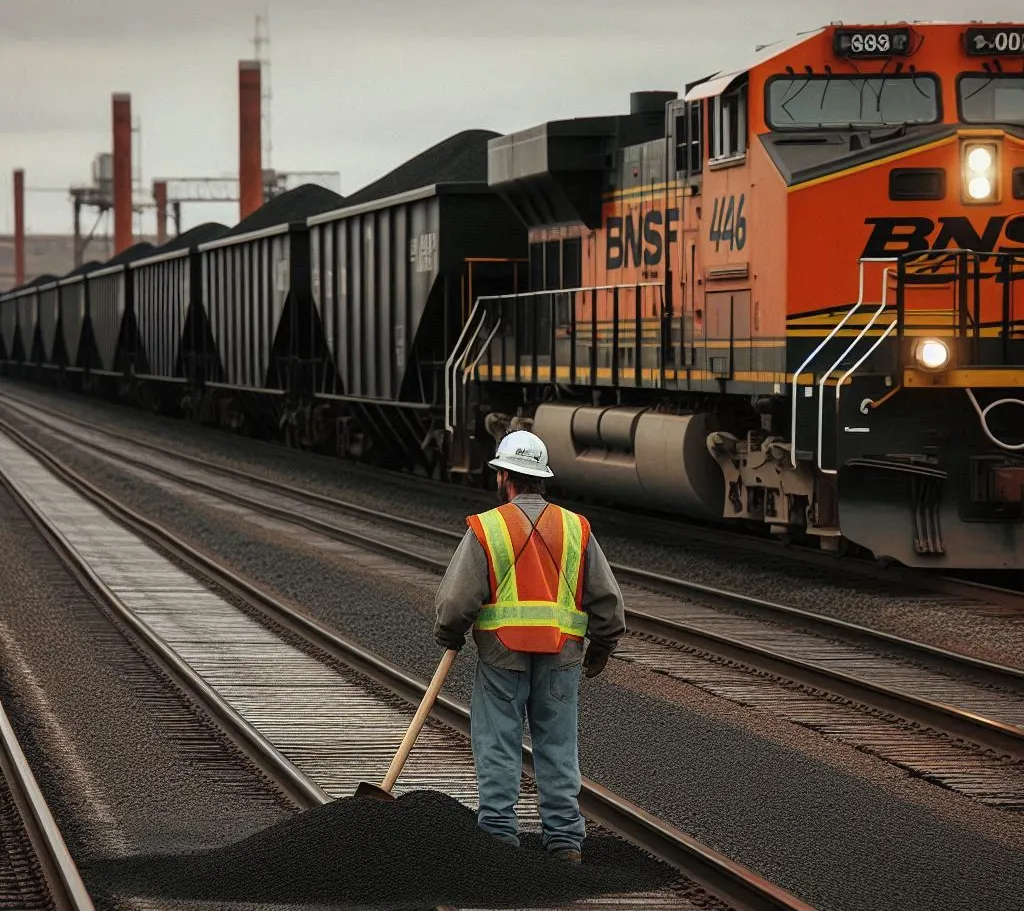Tags: Earnings / BNSF
This fanpage is not officially affiliated with Berkshire Hathaway: Disclaimer
We analyze BNSF's financial performance in H1 2024, examining slight earnings declines, operational efficiency, market dynamics, and strategic initiatives that promise future growth within Berkshire Hathaway's portfolio.

Introduction
BNSF Railway, a vital subsidiary of Berkshire Hathaway, stands as a cornerstone in Warren Buffett's diverse portfolio. Acquired in February 2010 for approximately $26.4 billion, this strategic investment has since propelled BNSF to become the No. 2 U.S. railroad company and a significant contributor to Berkshire Hathaway's growth 5. As we delve into 2024, BNSF's recent financial performance reveals a slight decline in earnings for the first half of the year compared to 2023, reflecting the dynamic challenges and opportunities in the railroad industry 1.
This article aims to provide Berkshire Hathaway shareholders with a comprehensive overview of BNSF's performance, challenges, and opportunities in the first half of 2024. The railroad industry, with its rich historical significance, remains a critical artery of American commerce and industry. Its role in transporting goods across vast distances underscores its importance in the broader economic landscape.
We will explore key themes such as financial performance, operational efficiency, market dynamics, and strategic initiatives. Additionally, we will reflect on the historical acquisition of BNSF by Berkshire Hathaway in 2010 and its profound impact on the company's growth trajectory 5 ↗. By blending historical insights with current market conditions, this analysis aims to offer a nuanced perspective on BNSF's journey through 2024.
Financial Performance Analysis
In Q2 2024, BNSF's financial results present a mixed picture, with railroad operating revenues remaining relatively unchanged. However, the first six months of 2024 saw a 2.0% decrease in operating revenues compared to the same period in 2023 1. This slight decline in earnings underscores the challenges faced by the railroad industry amidst fluctuating market conditions.
Comparing net earnings, BNSF reported $2.37 billion for the first half of 2024, down from $2.51 billion in the same period of 2023 1. Despite this decline, the performance remains relatively stable, reflecting BNSF's resilience in navigating economic headwinds. The stability of railroad operating revenues in Q2 2024, contrasted with the 2.0% decrease over the first six months, highlights the nuanced financial landscape BNSF operates within 1 - dollars in millions:
| BNSF Results of Operation | First Half 2024 | First Half 2023 |
|---|---|---|
| Railroad operating revenues | $ 11,361 | $ 11,592 |
| Railroad operating expenses: | ||
| Compensation and benefits | $ 2,725 | $ 2,691 |
| Fuel | $ 1,676 | $ 1,797 |
| Purchased services | $ 986 | $ 1,000 |
| Depreciation and amortization | $ 1,325 | $ 1,295 |
| Equipment rents, materials and other | $ 1,106 | $ 1,133 |
| Total | $ 7,818 | $ 7,916 |
| Railroad operating earnings | $ 3,543 | $ 3,676 |
| Interest expense | ($ 532) | ($ 513) |
| Other revenues (expenses), net | $ 130 | $ 101 |
| Pre-tax earnings | $ 3,141 | $ 3,264 |
| Income taxes | $ 771 | $ 753 |
| Net earnings | $ 2,370 | $ 2,511 |
A significant factor impacting overall revenue is the decline in average revenue per car/unit, which fell by 3.7% in Q2 2024 and 6.8% in the first six months of 2024 compared to 2023 1. This decline underscores the pricing pressures and competitive dynamics in the market. However, the increase in car/unit volumes, up by 4.2% in Q2 2024 and 5.4% in the first six months of 2024, suggests improvements in operational efficiency and capacity utilization 1.
Reflecting on BNSF's financial performance since its acquisition by Berkshire Hathaway, we observe a trajectory marked by significant milestones and trends. The strategic acquisition in 2010 not only solidified Berkshire Hathaway's position in the railroad industry but also set the stage for BNSF's continued growth and operational excellence 5 ↗ ↗. As we analyze the current financial performance, it is essential to consider these historical contexts to fully appreciate BNSF's journey through 2024 ↗.
Operational Efficiency and Challenges
BNSF's operational efficiency in 2024 has been a mixed bag, characterized by both significant improvements and notable challenges. One of the primary factors affecting BNSF's operating earnings has been litigation accruals, which have negatively impacted financial performance ↗. However, these setbacks have been partially offset by improved productivity and lower operating costs 1. This dichotomy underscores the complex landscape in which BNSF operates, balancing external pressures with internal efficiencies.
A critical component of BNSF's strategy to enhance operational efficiency has been the implementation of precision-scheduled railroading (PSR). PSR aims to optimize the utilization of crews and equipment, thereby reducing transfer times and increasing overall efficiency. While this approach has yielded some benefits, it has also faced criticism for its focus on short-term gains at the expense of long-term sustainability. Critics argue that PSR can lead to underinvestment in infrastructure and maintenance, increasing the risk of derailments and operational delays 7.
In a significant development, BNSF recently completed a multi-year mainline improvement project in Becker, New Mexico. This project, adjacent to BNSF's Belen facility—the largest fueling facility in North America—is expected to increase train capacity through the Southern Transcon route by approximately 30% 3. The Becker facility now boasts two new processing tracks, each around 20,000 feet long, designed for fueling, inspections, and crew changes. These improvements are anticipated to minimize the time trains spend stopping for fueling and inspections, thereby enhancing overall operational efficiency 3.
Historically, the railroad industry has evolved through various operational strategies, from the early days of steam engines to the modern era of diesel locomotives and advanced logistics. However, the industry has also grappled with underinvestment in infrastructure and maintenance, a challenge that continues to impact operational efficiency today. This underinvestment has been linked to a focus on operating ratios as a key efficiency metric, often at the expense of long-term infrastructure improvements 7.
While BNSF has made strides in improving operational efficiency through initiatives like PSR and the Becker mainline project, it must navigate the broader industry challenges of underinvestment and maintenance to sustain these gains. The balance between immediate operational efficiency and long-term sustainability remains a critical focus for BNSF as it moves forward.
However, operational efficiency is only one piece of the puzzle. Let's delve into the latest developments in BNSF's revenue streams, shaped by the dynamics of Mr. Market.

Market Dynamics and Revenue Streams
BNSF's revenue streams in 2024 have exhibited a diverse range of performances, reflecting the complex dynamics of the railroad market. The company's consumer products segment has been a standout performer, with operating revenues reaching $2.1 billion in Q2 2024 and $4.1 billion in the first six months of the year. These figures represent increases of 12.0% and 8.8%, respectively, from 2023, driven primarily by higher volumes of 15.0% in Q2 and 17.0% in the first six months 1. This growth underscores the robust demand for consumer goods transportation, even as the average revenue per car/unit has declined.
In contrast, the industrial products segment has faced challenges, with operating revenues declining by 0.4% in Q2 2024 and 0.9% in the first six months. This decline is attributed to reduced volumes of 1.5% and slightly lower revenue per car/unit 1. The industrial sector's performance reflects broader economic trends and fluctuations in demand for industrial goods.
The agricultural products segment has shown resilience, with operating revenues increasing by 10.1% in Q2 2024 and 3.1% in the first six months. These gains are driven by higher volumes of 10.8% in Q2 and 7.1% in the first six months, although they are partially offset by lower average revenue per car/unit 1. This segment's performance highlights the essential role of railroads in transporting agricultural commodities, which remain vital to the economy.
However, the most significant decline has been observed in the coal segment, with operating revenues plummeting by 35.0% in Q2 2024 and 30.1% in the first six months 🤔. The decline is due to reduced volumes of 28.9% in Q2 and 24.7% in the first six months, exacerbated by lower natural gas prices that have displaced coal as a fuel source for utilities 1. This trend reflects the broader shift in energy markets away from coal, driven by environmental concerns and the availability of cheaper alternatives; Natural gas prices have faced significant volatility in recent months, currently trading around $2.1 per million British thermal units (MMBtu). This marks a sharp decline from the peak of over $9 per MMBtu in the fall of 2022 9, which was driven by the impact of Russia's invasion of Ukraine.
Historically, coal was a dominant revenue source for railroads, but its decline has necessitated a shift in focus to other segments. The rise of consumer products and agricultural goods as key revenue drivers illustrates the evolving dynamics of the railroad market. As BNSF navigates these changes, it must continue to adapt its strategies to capitalize on emerging opportunities while mitigating the impact of declining segments like coal.
BNSF's diverse revenue streams reflect the broader market dynamics and the company's ability to adapt to changing economic conditions. The significant growth in consumer products and agricultural goods transportation, coupled with the challenges in industrial products and coal, underscores the need for a balanced and flexible approach to revenue generation.
Strategic Initiatives and Investments
BNSF Railway is strategically positioning itself to navigate the challenges of 2024 through a series of initiatives and investments aimed at enhancing operational efficiency and expanding capacity. One of the most significant projects is the multi-year mainline improvement in Becker, New Mexico, adjacent to BNSF's Belen facility, which is the largest fueling facility in North America. This project is expected to increase train capacity through the Southern Transcon route by approximately 30% 3. Jon Gabriel, VP of Service Design, emphasized the importance of Belen, stating, “Belen, New Mexico is really the heartbeat of our Southern Transcon, accounting for about a quarter of BNSF’s entire fuel usage and 25% of our volume” 3. The improvements, including two new 20,000-foot processing tracks, will minimize the time trains spend stopping for fueling and inspections, thereby enhancing overall efficiency.
In addition to operational enhancements, BNSF is deeply committed to safety and community engagement. The company recently announced the inaugural “Tracking to Zero” awards, recognizing states like Idaho, Montana, New Mexico, and Wyoming for their exemplary grade crossing safety records 4. BNSF’s Assistant Director of Public Projects, Richard Scott, remarked, “BNSF’s commitment and passion for safety sets us apart” 4. These awards are part of BNSF's broader vision to achieve zero grade crossing incidents by 2030, a goal supported by various state DOT actions such as installing grade-crossing separations and enhancing signal systems.
Moreover, BNSF's dedication to creating an inclusive workplace has been acknowledged with a top score of 100 on the Disability Equality Index for 2024, earning the title of “Best Place to Work for Disability Inclusion” for the second consecutive year 2. Dustin Almaguer, VP of Compliance and Audit, stated, “This recognition solidifies our efforts toward becoming a more inclusive and diverse place to work” 2. This accolade reflects BNSF’s comprehensive efforts in areas such as culture and leadership, enterprise-wide access, and community engagement.
Looking ahead, the Surface Transportation Board (STB) has scheduled a public hearing to discuss freight railroad investment and growth plans amid declining volume trends 6. This hearing will provide a platform for BNSF and other major railroads to present their short-, medium-, and long-term growth strategies. The STB's interest underscores the importance of regulatory oversight in ensuring sustainable growth and addressing industry challenges.
Potential future investments for BNSF include rail electrification and infrastructure upgrades, which promise substantial benefits. Electrified railroads are cheaper to operate, more reliable, and can significantly reduce emissions, aligning with broader environmental goals 7. Despite the clear advantages, American freight railroads have been slow to adopt electrification, primarily due to its perceived impact on operating ratios. However, public investment in rail infrastructure, such as the Infrastructure Investment and Jobs Act (2021), could catalyze these advancements, offering both public and shareholder benefits.
Industry Trends and Regulatory Environment
The railroad industry is currently grappling with several broader trends that have shaped its landscape over the past decade. One of the most pressing issues is the decline in carload volumes, which have decreased by 28% from May 2014 to May 2024, according to a Federal Reserve of St. Louis report 6. This decline is attributed to various factors, including high food and gas prices, political instability, and global conflicts, all of which have dampened consumer confidence and, consequently, railroad volumes 68.
In response to the challenges, the Surface Transportation Board (STB) is taking a proactive stance by holding a public hearing to scrutinize freight railroad investment and growth plans 6. This unprecedented move highlights the critical role of regulatory oversight in ensuring that railroads are adequately investing in their infrastructure and operations to support future growth. The STB's focus will be on understanding the short-, medium-, and long-term strategies of major railroads, including BNSF, and how these plans align with broader economic and environmental goals.
The Association of American Railroads (AAR) has also reported a significant drop in the Index of Consumer Confidence, influenced by various economic and geopolitical factors 6. This decline has had a direct impact on railroad volumes, exacerbating the industry's existing challenges. Railroads have traditionally focused on minimizing operating ratios, a metric that indicates efficiency but has also led to underinvestment in maintenance and infrastructure 7. This focus on short-term financial performance has sometimes come at the expense of long-term sustainability and operational reliability.
Historically, the regulatory environment for railroads has been shaped by policies that have both supported and hindered industry growth. The current landscape presents an opportunity for public investment in rail infrastructure, which could address many of the industry's systemic issues. Rail electrification and network-oriented improvements are particularly promising, offering significant climate and air quality benefits while providing a higher return on investment compared to traditional public works projects 7. The Infrastructure Investment and Jobs Act (2021) could be a pivotal source of funding for these initiatives, helping to modernize the rail network and enhance its competitiveness.
BNSF's strategic initiatives and the broader industry trends underscore the need for a balanced approach that prioritizes both operational efficiency and long-term sustainability. By investing in infrastructure upgrades, embracing regulatory oversight, and fostering an inclusive workplace, BNSF is well-positioned to navigate the challenges and seize the opportunities that lie ahead in 2024 and beyond ↗↗.

Conclusion
BNSF Railway's journey through the first half of 2024 has been characterized by relatively stable performance amid a backdrop of challenges, for example a strong revenue drop in coal cargo. Despite a 2.0% decrease in operating revenues and a decline in net earnings, BNSF has demonstrated resilience, reflecting its ability to navigate the complexities of the railroad industry 1. The company's strategic significance within Berkshire Hathaway's portfolio cannot be overstated, especially considering its pivotal role as the No. 2 U.S. railroad company following its acquisition in February 2010 for approximately $26.4 billion 5.
Looking ahead, the opportunities for future growth and improvement are promising. BNSF's commitment to operational efficiency, highlighted by initiatives such as the multi-year mainline improvement project in Becker, New Mexico, positions the company to enhance its capacity and service reliability 3. Additionally, the ongoing focus on safety and community engagement reflects a broader commitment to sustainable practices, which is essential for long-term success in the evolving railroad landscape.
The regulatory environment, particularly the attention from the Surface Transportation Board (STB), presents a unique opportunity for BNSF to align its growth strategies with industry standards and public interests 6. This oversight will likely encourage further investments in infrastructure and operational upgrades, which are crucial for maintaining competitive advantages in a market facing fluctuating demand and pricing pressures. BNSF likely holds a significant advantage in capital-intensive tasks, thanks to the substantial cash reserves of its parent company, Berkshire Hathaway ↗.
Moreover, the potential for rail electrification and infrastructure upgrades offers a forward-looking perspective that could drive significant benefits for BNSF. These advancements not only promise to enhance operational efficiency but also align with broader environmental goals, positioning BNSF as a leader in sustainable transportation solutions 7.
BNSF Railway is well-positioned to navigate the complexities of the railroad industry and capitalize on the opportunities that lie ahead. With a strong foundation built on historical significance and strategic foresight, the company is poised for continued growth and success in the years to come. Berkshire Hathaway shareholders can maintain a positive outlook on BNSF's journey, confident in its ability to adapt and thrive in an ever-evolving economic landscape.
References
-
2024 Second Quarter Report - BNSF - www.berkshirehathaway.com ↩↩↩↩↩↩↩↩↩↩↩↩
-
BNSF named Best Place to Work for Disability Inclusion for second straight year - www.bnsf.com ↩↩
-
BNSF completes new mainline improvement project in Becker/Belen NM - www.bnsf.com ↩↩↩↩↩
-
BNSF recognizes four states with inaugural award for grade crossing safety - www.bnsf.com ↩↩
-
Buffett unbound: Berkshire buys BNSF, joins S&P 500 - www.reuters.com ↩↩↩↩
-
Regulators nervous about rail freight decline - www.freightwaves.com ↩↩↩↩↩↩
-
Perverse Incentives Have Ruined America’s Railroads - ProMarket - www.promarket.org ↩↩↩↩↩↩
-
Rail News - U.S. rail volumes inch up in Week 23. For Railroad Career Professionals - www.progressiverailroading.com; Note: comparing the first 20 or so weeks of 2023 to 2024 shows a slight increase in U.S. freight-rail volumes, which provides some confidence for the near future. ↩
-
Natural gasPrice - Chart - Historical Data - News - tradingeconomics.com ↩












